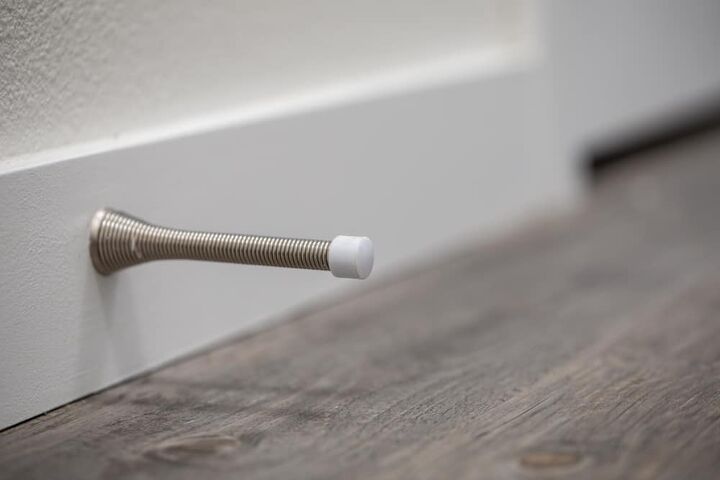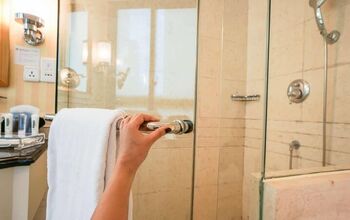12 Different Types of Door Stoppers

Door stoppers are incredibly useful hardware elements the protect walls from damage caused by doors and doorknobs. They are excellent at keeping paint or wallpaper looking great for longer and will help you evade having to repair or re-plaster your walls often – especially in high traffic areas of your home.
Like the majority of other door hardware, door stoppers are typically more functional than they are stylish. With that said, it’s usually best to choose the type of door stop based on which will be the most practical in your space and won’t stand out too much. Some of the most common door stoppers available include baseboard stoppers, wall-mounted stoppers, spring stoppers, floor stoppers, magnetic stoppers, hook stoppers, and security toppers.
Choosing a door stopper for your home may seem like an easy task, but when you’re presented with a variety of options it can become challenging to pick the right one. That’s where we come in! We’ve outlined the different types of door stoppers and how they work. Continue reading to find which door stop is right for your needs and your space.
How to Choose the Right Door Stopper
You might be surprised to find how many styles and types that door stoppers come in. Each stopper varies in how and where they prevent damage to walls caused by doors. The right type of door stopper for your space will largely depend on the type of door you have and the level of protection you need for your walls.
The main purpose of a door stopper is to eliminate possible damage to the adjoining wall next to your door. However, stoppers can also help to keep the door ajar and add a bit of visual appeal to the space. Additionally, security door stoppers can be implemented to enhance security in your home and keep intruders out.
Our list below will help you find the best door stopper to serve a functional purpose, decorative purpose, or even a security purpose:
1. Baseboard Door Stopper
When someone thinks of door stoppers, the baseboard type is often what first comes to mind. Baseboard door stoppers are, arguably, the most common. They are a peg-like metal piece that usually features a rubber tip and, as the name suggests, are affixed to the baseboard. These door stoppers cannot be installed on hollow-core doors, which is why they are commonly mounted to the baseboard of a wall.
In some cases, baseboard door stoppers have a spring that allows for flexibility and causes the door to bounce back slightly. Although, there are a number of rigid options available depending on your needs and preferences. These stoppers also come in a variety of metals, colors, and styles.
2. Wall-Mounted Stopper
Another common type of door stopper – especially in commercial settings – is wall-mounted, or wall bumper, doorstops. They are installed on the wall and designed to create a stopping point for the door. Similar to baseboard door stoppers, wall-mounted doorstops will cause the door to bounce back when it is swung hard. Though, these stoppers are installed higher up the wall and ideally where the doorknob is projected to meet the wall. This will help to prevent the doorknob from causing damage to the wall next to the door.
Wall-mounted door stoppers are great if you have tile floors, carpet, or any other flooring that prevents you from using floor stoppers. Most of them feature a plastic or rubber top that protects the wall and won’t cause damage to the door when it hits the stopper.
3. Spring Door Stopper
Spring door stoppers are similar to baseboard stoppers, except for the fact that they use a spring mechanism that prevents the door from hitting the wall, while also causing the door to bounce back. These stoppers can be installed directly on the wall adjacent to the door or on the baseboard of the wall. They are very flexible, heavy-duty, and work well for both residential and commercial applications.
Find out how to stop water coming in under a door threshold.
4. Floor Door Stopper
Floor door stoppers, also called floor-mounted doorstops, are installed on the floor instead of the wall. They are attached to the floor to prevent doors from opening wide enough to hit and cause damage to the wall. In order to function properly, these stoppers require a bit of space on the floor that adjoins the door.
Oftentimes, floor-mounted door stoppers are used when a stop is needed to protect the items in the pathway of the door, rather than the wall itself. These door stops come in a wide range of styles and shapes to serve different purposes. For instance, low-profile floor-mounted door stoppers are typically used in high-traffic areas to avoid tripping hazards. There are also some floor door stops that feature a magnet that keeps the door ajar when it comes in contact with it.
5. Magnetic Door Stopper
Magnetic door stops are one of the most versatile types of stoppers you can choose from, as they can be mounted on either your baseboard, wall, or floor to prevent damage to your walls. While you can use them pretty much anywhere, you’ll typically find magnetic door stoppers floor mounted.
They feature a powerful magnet that both prevents the door from slamming into the adjoining wall and holds the door open. Magnetic door stops are usually very decorative and come in a range of finishes to add some aesthetic appeal to your home or business.
6. Hinge Pin Door Stopper
As the name suggests, hinge pin door stoppers are attached to the door hinge. They are angled components that feature a rubber pad on either end that prevents the door from opening wide enough to bang into the wall. One of the major benefits of this type of door stopper is that they do not require you to install any additional hardware to the adjoining wall or baseboard.
Hinge pin door stoppers may not be the most decorative option out there, but they are one of the most discreet types of door stops. They also perform best on lightweight doors.
7. Hook Door Stopper
Hook door stoppers, or sometimes referred to as hinge door stops, provide nearly double the amount of protection as other types of door stops. They are a combination of a floor-mounted door stop with an additional hook and eyelet. The eyelet is installed directly on the bottom of the door. Although, you can also find some versions that are mounted onto the door, with the eyelet attached to the adjacent wall.
Regardless, hook door stoppers are ideal for doors that need to be propped open for extended periods of time. In many cases, they are similar to magnetic door stops as they both protect against damage caused by a swinging door and also hold the door open as needed.
8. Security Door Stopper
Security door stoppers are the ideal choice for those who are looking to safeguard their exterior doors. They are specifically designed for front doors or any other exterior door, as they block the door from being opened from the outside. Although, from the inside, you can easily open and close the door without any limitations.
Some security door stoppers feature a magnetic mechanism, while others are made out of cast iron or rubber. There are also some portable versions with audible alarms that, when the door is opened, will go off and scare away intruders. These types of security door stoppers are great for when you’re traveling, as they are small enough to fit in your carry-on and can be used to have some peace of mind in your hotel room.
Security door stoppers can be used on front doors, side doors, patio doors, and kitchen exterior doors.
9. Sliding Door Stopper
As the name suggests, sliding door stoppers are designed to be used on sliding doors or pocket doors. In most cases, these doorstops are concealed and wall-mounted to reduce the shock of a sliding door when it closes. Or, they may be installed on the track of the sliding door to prevent it from opening any further than the stoppers.
There are a number of sliding door stoppers that serve more of a security purpose. These are usually installed inside of the track of an exterior sliding patio door to prevent forced entry from the outside. You may find some sliding door stoppers commonly used on cabinet doors, depending on the design.
10. Barn Door Stoppers
Like sliding doors, barn doors must also have something to stop them. In this case, barn door stoppers are designed to stop the door from moving on the track and prevent it from falling off. These stoppers can be easily installed at the end of the rail, stopping them wherever you intend to fasten the bolts. The barn door stoppers pictured above can be purchased from Amazon.
10. Door Chocks
Although technically not a type of door stopper, door chocks are an excellent alternative that does a great job at holding doors open. They are installed on the door hinge to prevent the door from slamming. These fold up door stops were developed out of necessity for firefighters. Gone are the days of firefighters having to carry around wedges that hardly work at holding doors open or bulky pieces of iron that don’t fit in their pockets.
With door chocks, firefighters don’t have to worry about doors shutting behind them or their hose lines getting pinched inside of closed doors. These stoppers will work on any door hinge and fold up easily to fit in your pocket. While they were designed for firefighters, they can be used by anyone. In fact, door chocks make a wonderful choice for kid’s rooms as they come in a wide variety of fun colors.
11. Kick-Down Door Stopper
Kick-down door stoppers, also referred to as flip-down door stops, are attached to the base of the door and function similar to the kickstand on a bicycle. Their main function is to keep doors from opening up too far. However, instead of preventing the door from opening too far automatically or protecting the wall from damage, kick-down door stoppers must be manually activated in order to prop the door open.
These door stoppers can be easily operated with your foot and are commonly found in commercial and industrial settings. Kick-down door stoppers are ideal for exterior doors that are opened frequently and need something to help hold the door open. They are especially convenient since they are attached to the door, which eliminates possible tripping hazards associated with having a stopper installed on the floor.
12. Wedge Door Stopper
Wedge door stops are one of the simplest versions of a doorstop. They consist of a single wedge-shaped piece that is inserted under the edge of a door to prevent it from moving in one direction or another. These door stops do not have to be mounted to the wall, door, or floor in any way. They are a temporary solution that allows you to move the stopper from door to door as needed.
Oftentimes, wedge door stops are made out of a durable rubber material that slides easily under the door. You can place it on the side of the door face the wall to prevent damage to the wall, or on the opposite side to hold the door open for a brief period of time.
Additional Door Stopper Considerations
The type of door stopper you choose ultimately depends on the type of door, location, function, and surrounding area. With these factors in mind, consider the following:
- If you have ornate, decorate baseboards, you likely want to avoid using spring stoppers or baseboard door stops.
- If you have tiled flooring, a floor-mounted door stopper is likely not the best choice.
- For most interior doors, a basic hinge pin or spring stop will work just fine. Keep in mind that for larger doors, like your front door, you will probably need two hinge pin stoppers – one on the top hinge and one on the bottom.
- If your home is prone to drafts and your doors tend to swing open or closed on their own, you will greatly benefit from a magnetic door stopper.
Related Articles

Jessica considers herself a home improvement and design enthusiast. She grew up surrounded by constant home improvement projects and owes most of what she knows to helping her dad renovate her childhood home. Being a Los Angeles resident, Jessica spends a lot of her time looking for her next DIY project and sharing her love for home design.
More by Jessica Stone

































